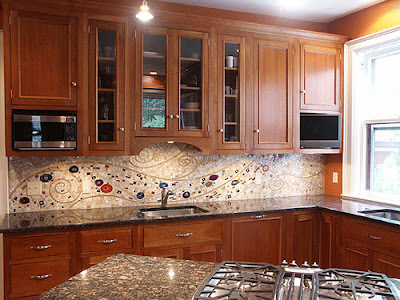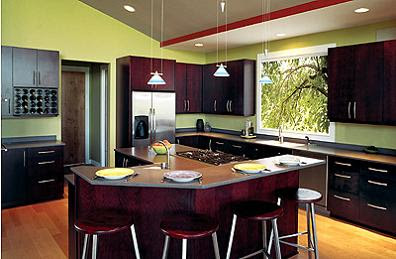Color is very important design element for kitchens and bathrooms since it plays an important role in affecting our modes.
A good combination of Kitchen Colors in the scheme of your decoration can make your kitchen look livelier and more appealing. However mismatched color schemes can ruin your décor.
Color can influence the mood of a room. For example, studies have shown that red can quicken the pulse and breathing rate, as well as increase appetite. Yellow, especially soft yellows can make people feel happier. When used as a accent bright yellow can attract attention and brighten up a kitchen. You can also use color to influence how large or small a kitchen can feel.
With kitchen color taking on more importance, many manufacturers of cabinets, appliances, flooring and countertops are offering the consumer more choices in colors. The best Kitchen Colors should include shades of brown, peach, yellow, pink or blue.
Kitchen color schemes have come and gone over the years. Some kitchen color schemes have remained popular over time.
White as a kitchen color remains a popular choice because of it has a clean look. One disadvantage of an all-white kitchen is that it can have a sterile and cold look and feel. That is why white is usually accented with one other color such as blue. Also design elements such as a light colored oak floor, or soft accents provided by curtains can make a kitchen seem warmer. It is considered a good idea to select one color as the overall or base color and select one or two accent colors.
You can feel safe selecting just about any color for your kitchen by following some important guidelines
for using different kitchen color schemes:
It is considered a good idea in using color in a room to have a 60-30-10 split between three colors,
60% representing the main or dominant color, probably on the walls or cabinets. 30% of a secondary color used in the flooring or rugs, as well as window treatments. 10% for accents such as, dishes, artwork, pillows and other soft items.
Monochromatic color scheme is noted for only the use of one color. To create more variety you would used various tints, tones and shades of that color.
Complementary color scheme uses two colors placed opposite to each other on the color wheel. This scheme is quite intense and brings a more dramatic touch and energy to home décor.







0 comments:
Post a Comment